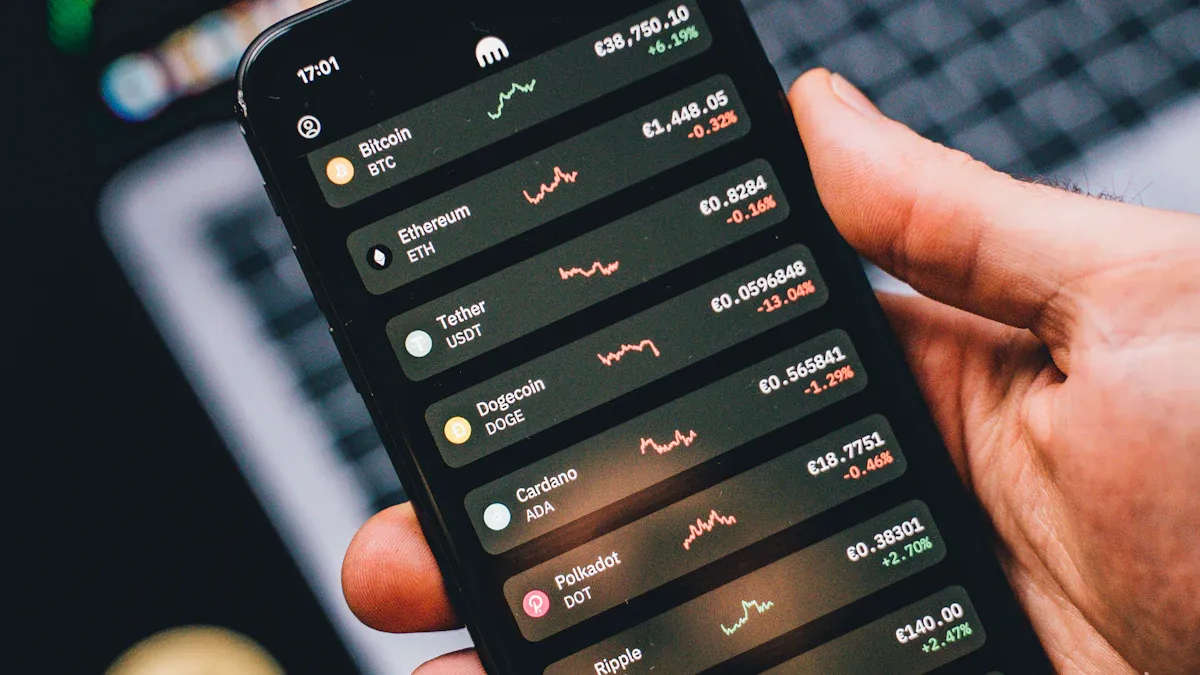What Does DYOR Stand for in Crypto Investing and Why It Matters
2025-06-03 08:14:35
In the world of cryptocurrency, "what does DYOR stand for in crypto investing?" is a question many beginners ask. DYOR, or "do your own research," is a guiding principle that every investor should follow. It encourages individuals to dive into the details of a project rather than relying on others' opinions. Why does it matter? Because the crypto market is full of risks, from volatile price swings to deceptive schemes. By taking the time to research, investors can spot red flags and make smarter decisions. DYOR isn't just a phrase—it's a shield against costly mistakes.
Why DYOR Is Essential in Crypto Investing

Avoiding Scams and Fraudulent Projects
The cryptocurrency market has seen its fair share of scams and fraudulent projects. From fake initial coin offerings (ICOs) to rug pulls, these schemes often prey on uninformed investors. This is where DYOR becomes a critical tool. By thoroughly researching a project, investors can identify red flags before committing their funds. For instance, reviewing a project's whitepaper can reveal whether it has a clear purpose or if it’s filled with vague promises. Similarly, checking the team’s background can help determine if they have the expertise to deliver on their claims.
Investors should also be cautious of unsolicited advice and projects with low liquidity. These are often easier to manipulate and can lead to significant losses. Transparency is another key factor. Legitimate projects are upfront about their goals, partnerships, and progress. When investors take the time to verify this information, they reduce their chances of falling victim to scams. As a rule of thumb, skepticism is healthy in the crypto world. If something seems too good to be true, it probably is.
Understanding Market Volatility and Risks
Cryptocurrency markets are notoriously volatile. Prices can skyrocket one day and plummet the next. This unpredictability makes risk management essential for any investor. DYOR helps individuals understand the factors driving market movements. For example, analyzing a project’s tokenomics can provide insights into its potential value. Factors like total supply, distribution schedule, and utility play a significant role in price stability.
Additionally, assessing the credibility of a project’s team can help investors gauge its long-term viability. Anonymous teams often carry higher risks, as they lack accountability. Security audits are another aspect to consider. Projects with audited smart contracts are less likely to have vulnerabilities that could lead to financial losses. By staying informed about these elements, investors can make better decisions and navigate the market’s ups and downs more effectively.
Benefits of Informed Decision-Making for Investors
Informed decision-making is a cornerstone of successful investing, especially in the cryptocurrency space. When investors take the time to verify a project’s legitimacy, they gain confidence in their choices. This reduces the likelihood of emotional decisions driven by fear or greed. For instance, understanding a project’s fundamentals can help investors focus on its long-term potential rather than short-term price fluctuations.
Thorough research also enables investors to identify genuine opportunities. Verifying partnerships and team profiles ensures that the information presented is accurate and not misleading. This level of diligence not only minimizes risks but also maximizes the chances of achieving favorable outcomes. In a market as dynamic as cryptocurrency, informed decision-making is not just beneficial—it’s essential.
Conducting Your Own Research Effectively
Evaluating Project Websites and Whitepapers
A project’s website and whitepaper are often the first places to start when conducting your own research. These resources provide a wealth of information about the project’s goals, technology, and roadmap. However, not all websites and whitepapers are created equal. Some may look professional but lack substance, while others might intentionally obscure critical details.
To evaluate these resources effectively, investors should focus on identifying potential risks. For instance, operational risks, legal uncertainties, and technology-related vulnerabilities can significantly impact a project’s success. The table below outlines common risk types and their implications:
| Risk Type | Description |
|---|---|
| Operational Risks | Failures in operational integrity might lead to disruptions, financial losses, or reputational damage. |
| Legal Risks | Legal uncertainties, potential lawsuits, or adverse legal rulings can pose significant risks to issuers. |
| Reputational Risks | Negative publicity can damage an issuer’s reputation and, by extension, the value of the crypto-asset. |
| Market and Liquidity Risks | The token’s price may fluctuate significantly, resulting in potential losses due to market volatility. |
| Technology-Related Risks | Risks associated with the technology used in the project, including smart contract and network security risks. |
| Mitigation Measures | Comprehensive testing of smart contracts and user education on secure key management to minimize risks. |
By carefully reviewing a project’s whitepaper, investors can assess whether the team has addressed these risks and proposed mitigation strategies. A well-written whitepaper should clearly explain the project’s purpose, use case, and technical framework. If the document is filled with jargon or vague promises, it’s a red flag worth noting.
Assessing Team Credibility and Background
The people behind a cryptocurrency project play a crucial role in its success. A strong, experienced team inspires confidence, while an anonymous or unqualified group raises concerns. When assessing a team’s credibility, investors should look into the backgrounds of key developers, advisors, and executives.
Here are some key factors to consider:
- Team credentials: Check if the team members have relevant experience in blockchain technology, software development, or the industry the project aims to disrupt.
- Past projects: Research their involvement in previous ventures. A track record of successful projects adds credibility.
- Transparency: Verify if the team is open about their identities and qualifications. Anonymous teams often carry higher risks.
Investors can also explore professional networking platforms like LinkedIn to validate the team’s profiles. If the team’s claims don’t align with publicly available information, it’s a warning sign that shouldn’t be ignored.
Verifying Partnerships and Collaborations
Partnerships and collaborations can significantly enhance a project’s credibility and market potential. However, not all partnerships are genuine. Some projects exaggerate or fabricate their affiliations to attract investors. This makes verifying partnerships a critical step in conducting your own research.
Here’s why partnerships matter:
- Validation and Credibility: Collaborations with reputable firms lend legitimacy to a project, boosting investor confidence.
- Market Access: Partnerships with established businesses can open doors to new markets and increase adoption.
To verify a partnership, investors should look for official announcements from both parties. Cross-checking this information on the partner’s website or social media channels can confirm its authenticity. If a project claims a partnership but lacks evidence, it’s a red flag that warrants further investigation.
Analyzing Tokenomics and Market Trends
Tokenomics plays a vital role in understanding the potential of any cryptocurrency project. It refers to the economic model behind a token, including its supply, distribution, and utility. Investors who take the time to analyze tokenomics can gain insights into a project's sustainability and growth potential. For example, a token with a limited supply and high demand might experience price appreciation, while one with an excessive supply could face inflationary pressures.
When evaluating tokenomics, consider these key factors:
- Total Supply and Circulating Supply: A token's total supply indicates how many tokens will ever exist, while the circulating supply shows how many are currently available in the market. A significant gap between the two might signal future inflation.
- Distribution Model: Check how tokens are allocated. Are they fairly distributed among the community, or do a few wallets hold the majority? Uneven distribution can lead to price manipulation.
- Utility: Understand the token's purpose. Does it serve a real use case, or is it purely speculative? Tokens with strong utility often have better long-term prospects.
Market trends also provide valuable context for decision-making. By observing price charts, trading volumes, and market sentiment, investors can identify patterns and potential opportunities. For instance, a sudden spike in trading volume might indicate growing interest in a project. However, it's essential to differentiate between organic growth and artificial hype created by pump-and-dump schemes.
Pro Tip: Use blockchain explorers like Etherscan or BscScan to verify token distribution and activity. These tools offer transparency and help you spot unusual patterns, such as concentrated holdings or suspicious transactions.
Staying informed about tokenomics and market trends equips investors with the knowledge to make smarter decisions. It also reduces the likelihood of falling for projects that lack substance or sustainability.
Cross-Checking Information from Reliable Sources
In the cryptocurrency space, misinformation spreads quickly. That’s why cross-checking information is a crucial step when conducting your own research. Relying on a single source can lead to biased or incomplete conclusions. Instead, gather data from multiple reputable platforms to ensure accuracy.
Here’s how to approach this:
- Use Trusted News Platforms: Websites like CoinDesk, CoinTelegraph, and Decrypt provide reliable updates on the crypto market. Compare their reports to identify consistent facts.
- Verify Social Media Claims: Many projects promote themselves on platforms like Twitter, Reddit, or Telegram. While these channels can offer insights, they’re also prone to exaggeration. Always confirm claims through official announcements or third-party sources.
- Check Blockchain Data: Blockchain explorers allow you to verify transaction histories, token distributions, and wallet activities. This data is immutable and provides an unbiased view of a project’s activity.
- Consult Community Forums: Platforms like BitcoinTalk or dedicated subreddits often host discussions about new projects. While these forums can be helpful, approach them with caution. Look for well-reasoned arguments rather than emotional or promotional posts.
Note: Be wary of influencers or "crypto gurus" who promise guaranteed returns. Genuine investments come with risks, and no one can predict the market with certainty.
Cross-checking information not only helps you avoid scams but also builds confidence in your investment decisions. It’s a practice that every investor should adopt to navigate the complexities of the crypto market effectively.
Common Pitfalls to Avoid When Conducting Research
Falling for Social Media Hype
Social media can be a double-edged sword for cryptocurrency investors. While platforms like Twitter, Reddit, and TikTok offer quick updates, they also amplify hype that can cloud judgment. Many projects gain traction not because of their fundamentals but due to viral posts or influencer endorsements. This creates a dangerous environment where emotions often override logic.
Consider these examples of how social media hype has influenced investment decisions:
| Case Study/Data Point | Description |
|---|---|
| Gen Z Trust in Influencers | 48% of Gen Z investors invest "for fun"; 44% base decisions on online buzz. |
| Influence of Financial Influencers | 59% of investors following influencers made investments based on recommendations; 36% regretted it. |
| GameStop Saga | Retail investors drove GameStop shares from under $20 to over $400. |
| Dogecoin Surge | Dogecoin rose over 15,000% in early 2021, fueled by social media excitement. |
| Terra (LUNA) Collapse | UST lost $60 billion in market value after heavy promotion by influencers. |
These cases highlight the risks of relying on hype instead of conducting your own research. Investors should focus on a project's fundamentals and avoid making decisions based solely on trending hashtags or viral posts.
Ignoring Warning Signs in Projects
Red flags in cryptocurrency projects often go unnoticed when investors rush into decisions. Warning signs like vague whitepapers, anonymous teams, or unrealistic promises should raise immediate concerns. For instance, projects that guarantee "risk-free" returns or claim partnerships without evidence often turn out to be scams.
Another common issue is ignoring token distribution. If a small group holds most of the tokens, they can manipulate prices, leaving others at a loss. Investors should also watch for projects with no clear use case or roadmap. These often lack long-term viability. Spotting these warning signs early can save investors from significant losses.
Overlooking the Importance of Diversified Research
Relying on a single source of information is a recipe for disaster. Many investors fall into the trap of trusting one website, influencer, or forum without cross-checking facts. This approach increases the risk of falling for misinformation or biased opinions.
Diversified research is essential for effective risk management. Investors should consult multiple sources, including project websites, blockchain explorers, and reputable news platforms. Engaging with community forums can also provide valuable insights, but it's crucial to separate genuine discussions from promotional content. By diversifying their research, investors can make well-rounded decisions and avoid being misled.
Tip: Always verify claims through official channels and blockchain data. Avoiding misinformation is key to protecting your investments.
Tools and Resources for Conducting Your Own Research

Using Crypto News Platforms and Forums
Crypto news platforms and forums are excellent starting points for staying updated on market trends and project developments. Websites like CoinDesk and CoinTelegraph provide reliable news and analysis. They cover everything from regulatory updates to new project launches. Forums such as Reddit and BitcoinTalk offer a space for discussions and opinions from the crypto community. These platforms can help investors gauge market sentiment and discover emerging opportunities.
However, not all information on forums is trustworthy. Some posts may be biased or promotional. To avoid misinformation, investors should cross-check details with other sources. Engaging in discussions can be helpful, but it’s essential to focus on well-reasoned arguments rather than emotional or hype-driven posts.
Leveraging Blockchain Explorers and Analytics Tools
Blockchain explorers like Etherscan and BscScan are invaluable tools for verifying data. They allow users to track transactions, monitor wallet activity, and analyze token distribution. For example, investors can check if a project’s tokens are evenly distributed or concentrated in a few wallets. This transparency helps identify potential risks, such as price manipulation.
Analytics tools like CoinMarketCap and Glassnode provide additional insights. They offer data on trading volumes, market capitalization, and historical price trends. These tools make it easier to spot patterns and assess a project’s performance over time. By combining blockchain explorers with analytics platforms, investors can gain a comprehensive view of the market.
Accessing Educational Content and Tutorials
Educational resources play a crucial role in improving crypto research skills. Comprehensive knowledge bases explain the basics of cryptocurrencies, helping beginners understand key concepts. Tutorials guide users through practical steps like setting up wallets or making transactions. Interactive formats, such as webinars and live Q&A sessions, enhance engagement and make learning more effective.
These resources empower investors to make informed decisions. They also reduce the chances of falling for scams or misinformation. By dedicating time to learning, individuals can build a strong foundation for their crypto journey. DYOR becomes much easier when investors have access to quality educational content.
Tip: Look for tutorials and webinars hosted by reputable organizations or experts. This ensures the information is accurate and up-to-date.
DYOR remains a cornerstone of successful crypto investing. It empowers individuals to make educated investment decisions by uncovering critical details about projects and market trends. This practice not only reduces risks but also builds confidence in navigating the ever-changing crypto landscape.
Investors should treat DYOR as an ongoing habit rather than a one-time effort. The crypto market evolves rapidly, and staying informed is key to staying ahead. By committing to thorough research, investors can protect their assets and seize genuine opportunities in this dynamic space.
Remember, in crypto, knowledge is your greatest asset.
FAQ
What does DYOR mean in crypto investing?
DYOR stands for "Do Your Own Research." It encourages investors to independently investigate cryptocurrency projects before making decisions. This practice helps identify risks, avoid scams, and make informed choices.
Why is DYOR important for beginners?
Beginners often lack experience in spotting red flags. DYOR empowers them to understand projects, evaluate risks, and avoid blindly following hype or advice from others.
How can I start researching a crypto project?
Begin by reviewing the project’s website and whitepaper. Check the team’s credentials, verify partnerships, and analyze tokenomics. Use tools like blockchain explorers to confirm data.
Tip: Always cross-check information from multiple reliable sources to ensure accuracy.
What are common mistakes to avoid during research?
Avoid relying solely on social media or influencers. Don’t ignore warning signs like vague promises or anonymous teams. Always diversify your research to get a complete picture.
Are there tools to help with DYOR?
Yes! Platforms like CoinMarketCap, Etherscan, and CoinTelegraph provide valuable insights. Blockchain explorers and analytics tools can help verify data and track trends.
Emoji Tip: 🛠️ Use these tools to dig deeper into project details and make smarter decisions.